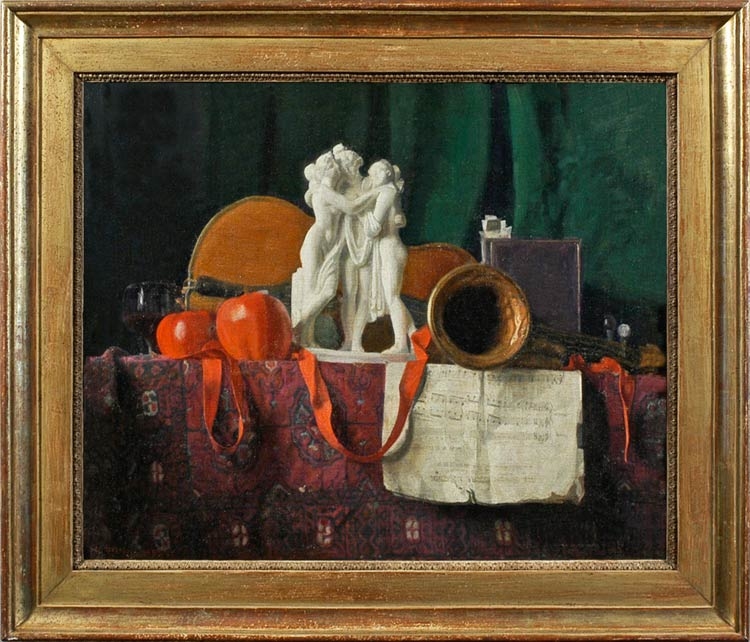Another composition by Weissbort which refers to a painting by Chardin: this time the large Still life with attributes of the Arts (versions in the Hermitage Museum and Minneapolis Institute of Arts). This is an ambitious homage to a rich and complex work, orchestrating a number of items into a pattern of line, form, colour and texture which will echo the harmonies of the earlier picture. Chardin’s work uses attributes of the visual arts (painting, architecture, drawing, metalwork and sculpture) in his group of items, with the medal of the Order of St Michael prominent (the highest honour for an artist). Weissbort’s work celebrates the aural arts, with musical instruments, sheet music, and a statuette of the Three Graces who seem to listen to music, and to be about to dance. Terpsichore, the muse of dance, usually carries a lyre, whilst Euterpe, associated with music, has a double flute, the equivalent here of Weissbort’s trumpet and viol; whilst the Muses when dancing often have flying ribbons or scarves. Chardin’s painting is full of rich earth colours, lifted by scarlet and deep blue; Weissbort’s is softer, with warm deep reds and russets against a dull teal ground.
Biographical details
George Weissbort (1928-2013) was born in Belgium and moved to London at the age of 7. He attended the Central School of Art & Design (now St Martin’s) where he was taught by Ruskin Spear and Rodrigo Moynihan. He was influenced by Arthur Segal to move from the abstract expressionism of the 1940s to realism, and by Bernard Meninsky, who taught life drawing at the Central School, to study the Old Masters. He turned first to artists such as Cézanne and Matisse, and later to Vermeer, Chardin, Velasquez, Corot, Titian, Holbein, and Piero della Francesca, amongst others.
He exhibited regularly at the Royal Academy, the Royal Society of Portrait Painters and the Fine Art Society. In 1964-65 he had a large exhibition in Paris, and in 2006 he had a one-man retrospective at the Chambers Gallery, London, followed in 2008 by another at the Denise Yapp Gallery, Whitebrook, Monmouth.
He wrote essays on art and criticism which look both at the techniques of making a painting, and of appreciating a work of art. The latter skill he believed came only after years of consciously training the eye to see as the artist saw, considering for example the ‘negative’ spaces around and between objects. He also discussed the work of specific artists, such as Lucien Freud and Vermeer.
His obituary in The Independent quotes Brian Sewell, a friend, as saying of him that Weissbort ‘painted the right pictures at the wrong time’. His appeal was to those who understood his models and influences; he could be described as a painter’s painter, and the same obituary quotes Paula Rego describing him as ‘a truly honest artist who knows so much about painting’.
Publications: George Weissbort, Paintings and Drawings (Parnassus, 2008), ill. 130 colour plates; includes transcripts of a filmed interview; essays by Tony Rudolph, David Lee and Bernard Dunstan RA.
YouTube video: A tribute to George Weissbort by John French.


